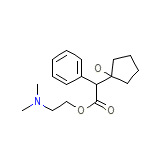Ocu-Pentolate




Ocu-Pentolate Brand names, Ocu-Pentolate Analogs
Ocu-Pentolate Brand Names Mixture
- No information avaliable
Ocu-Pentolate Chemical_Formula
C17H25NO3
Ocu-Pentolate RX_link
No information avaliable
Ocu-Pentolate fda sheet
Ocu-Pentolate msds (material safety sheet)
Ocu-Pentolate Synthesis Reference
No information avaliable
Ocu-Pentolate Molecular Weight
291.385 g/mol
Ocu-Pentolate Melting Point
139 oC (hydrochloride salt)
Ocu-Pentolate H2O Solubility
No information avaliable
Ocu-Pentolate State
Solid
Ocu-Pentolate LogP
3.124
Ocu-Pentolate Dosage Forms
Ophthalmic solution (eye drops)
Ocu-Pentolate Indication
Used mainly to produce mydriasis and cycloplegia for diagnostic purposes.
Ocu-Pentolate Pharmacology
Cyclopentolate is an anti-muscarinic in the same class as atropine and scopolamine. Cyclopentolate blocks the receptors in the muscles of the eye (muscarinic receptors). These receptors are involved controlling the pupil size and the shape of the lens. Cyclopentolate thus induces relaxation of the sphincter of the iris and the ciliary muscles. When applied topically to the eyes, it causes a rapid, intense cycloplegic and mydriatic effect that is maximal in 15 to 60 minutes; recovery usually occurs within 24 hours. The cycloplegic and mydriatic effects are slower in onset and longer in duration in patients who have dark pigmented irises.
Ocu-Pentolate Absorption
Absorbed following ophthalmic administration.
Ocu-Pentolate side effects and Toxicity
Oral LD50 in the rat is 4000 mg/kg and 960 mg/kg in the mouse. Symptoms of overdose include tachycardia, dizziness, dry mouth, behavioral disturbances, uncoordination and drowsiness.
Ocu-Pentolate Patient Information
No information avaliable
Ocu-Pentolate Organisms Affected
Humans and other mammals














